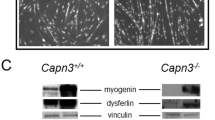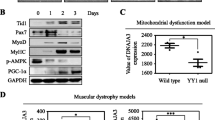Abstract
The precise role of δ-sarcoglycan (SG) that is constitutively expressed in skeletal muscle cells and may serve for maintaining the sarcolemmal integrity has not been identified. The δ-SG protein is at first among SG complex. To specifically identify the role in C2C12 cells during the myogenesis, we screened several RNA interference (RNAi) candidates at first, and knocked down both levels of the mRNA and protein, employing adenovirus-mediated RNAi. We found no morphological alteration at both myoblast and myotube stages by suppression of δ-SG. The specific knockdown of δ-SG accompanied a concomitant decrease of α-, β-, and γ-SGs preserving normal levels of each transcript. As for the localization, α-, β-, and γ-SGs were weakly stained on the cell membrane in δ-SG knockdown cells, whereas each SG in control cell was localized both on the cell membrane and myoplasm abundantly. This enhanced post-translational loss would represent similitude of the progression of cardiomuscular diseases in vitro. Different from cardiac muscle cells, skeletal muscle cell culture without muscle contraction may imply that mechanical stress per se is not primarily involved in the progression of limb-girdle muscular dystrophy. Furthermore, we have observed translocation of calpain-2 to cell membrane in δ-SG knockdown cells, suggesting that Ca2+-sensitive proteases, calpains closely take part in post-translational proteolysis.






Similar content being viewed by others
References
Bushby KM (1999) The limb-girdle muscular dystrophies-multiple genes, multiple mechanisms. Hum Mol Genet 8:1875–1882. doi:10.1093/hmg/8.10.1875
Homburger F (1972) Disease models in Syrian hamsters. Prog Exp Tumor Res 16:69–86
Towbin JA, Bowles NE (2002) The failing heart. Nature 415:227–233. doi:10.1038/415227a
Durbeej M, Campbell KP (2002) Muscular dystrophies involving the dystrophin-glycoprotein complex: an overview of current mouse models. Curr Opin Genet Dev 12:349–361. doi:10.1016/S0959-437X(02)00309-X
Nigro V, Okazaki Y, Belsito A, Piluso G, Matsuda Y, Politano L, Nigro G, Ventura C, Abbondanza C, Molinari AM, Acampora D, Nishimura M, Hayashizaki Y, Puca GA (1997) Identification of the Syrian hamster cardiomyopathy gene. Hum Mol Genet 6:601–607. doi:10.1093/hmg/6.4.601
Sakamoto A, Ono K, Abe M, Jasmin G, Eki T, Murakami Y, Masaki T, Toyo-oka T, Hanaoka F (1997) Both hypertrophic and dilated cardiomyopathies are caused by mutation of the same gene, delta-sarcoglycan, in hamster: an animal model of disrupted dystrophin-associated glycoprotein complex. Proc Natl Acad Sci USA 94:13873–13878. doi:10.1073/pnas.94.25.13873
Tsubata S, Bowles KR, Vatta M, Zintz C, Titus J, Muhonen L, Bowles NE, Towbin JA (2000) Mutations in the human delta-sarcoglycan gene in familial and sporadic dilated cardiomyopathy. J Clin Invest 106:655–662. doi:10.1172/JCI9224
Kawada T, Nakazawa M, Nakauchi S, Yamazaki K, Shimamoto R, Urabe M, Nakata J, Hemmi C, Masui F, Nakajima T, Suzuki J, Monahan J, Sato H, Masaki T, Ozawa K, Toyo-oka T (2002) Rescue of hereditary form of dilated cardiomyopathy by rAAV-mediated somatic gene therapy: amelioration of morphological findings, sarcolemmal permeability, cardiac performances, and the prognosis of TO-2 hamsters. Proc Natl Acad Sci USA 99:901–906. doi:10.1073/pnas.022641799
Toyo-oka T, Kawada T, Nakata J, Xie H, Urabe M, Masui F, Ebisawa T, Tezuka A, Iwasawa K, Nakajima T, Uehara Y, Kumagai H, Kostin S, Schaper J, Nakazawa M, Ozawa K (2004) Translocation and cleavage of myocardial dystrophin as a common pathway to advanced heart failure: a scheme for the progression of cardiac dysfunction. Proc Natl Acad Sci USA 101:7381–7385. doi:10.1073/pnas.0401944101
Kawada T, Masui F, Tezuka A, Ebisawa T, Kumagai H, Nakazawa M, Toyo-oka T (2005) A novel scheme of dystrophin disruption for the progression of advanced heart failure. Biochim Biophys Acta 1751:73–81
Kawada T, Nakatsuru Y, Sakamoto A, Koizumi T, Shin WS, Okai-Matsuo Y, Suzuki J, Uehara Y, Nakazawa M, Sato H, Ishikawa T, Toyo-oka T (1999) Strain- and age-dependent loss of sarcoglycan complex in cardiomyopathic hamster hearts and its re-expression by delta-sarcoglycan gene transfer in vivo. FEBS Lett 458:405–408. doi:10.1016/S0014-5793(99)01164-3
Takahashi M, Tanonaka K, Yoshida H, Koshimizu M, Daicho T, Oikawa R, Takeo S (2006) Possible involvement of calpain activation in pathogenesis of chronic heart failure after acute myocardial infarction. J Cardiovasc Pharmacol 47:413–421
Gastaldello S, D’Angelo S, Franzoso S, Fanin M, Angelini C, Betto R, Sandona D (2008) Inhibition of proteasome activity promotes the correct localization of disease-causing alpha-sarcoglycan mutants in HEK-293 cells constitutively expressing beta-, gamma-, and delta-sarcoglycan. Am J Pathol 173:170–181. doi:10.2353/ajpath.2008.071146
Bonuccelli G, Sotgia F, Capozza F, Gazzerro E, Minetti C, Lisanti MP (2007) Localized treatment with a novel FDA-approved proteasome inhibitor blocks the degradation of dystrophin and dystrophin-associated proteins in mdx mice. Cell Cycle 6:1242–1248
Bradford MM (1976) A rapid and sensitive method for the quantitation of microgram quantities of protein utilizing the principle of protein-dye binding. Anal Biochem 72:248–254. doi:10.1016/0003-2697(76)90527-3
Liu LA, Engvall E (1999) Sarcoglycan isoforms in skeletal muscle. J Biol Chem 274:38171–38176. doi:10.1074/jbc.274.53.38171
Shi W, Chen Z, Schottenfeld J, Stahl RC, Kunkel LM, Chan YM (2004) Specific assembly pathway of sarcoglycans is dependent on beta- and delta-sarcoglycan. Muscle Nerve 29:409–419. doi:10.1002/mus.10566
Goll DE, Thompson VF, Li H, Wei W, Cong J (2003) The calpain system. Physiol Rev 83:731–801
Honda M, Masui F, Kanzawa N, Tsuchiya T, Toyo-oka T (2008) Specific knockdown of m-calpain blocks myogenesis with cDNA deduced from the corresponding RNAi. Am J Physiol Cell Physiol 294:C957–C965. doi:10.1152/ajpcell.00505.2007
Chang HS, Lin CH, Chen YC, Yu WC (2004) Using siRNA technique to generate transgenic animals with spatiotemporal and conditional gene knockdown. Am J Pathol 165:1535–1541
Hommel JD, Sears RM, Georgescu D, Simmons DL, DiLeone RJ (2003) Local gene knockdown in the brain using viral-mediated RNA interference. Nat Med 9:1539–1544. doi:10.1038/nm964
Peng S, York JP, Zhang P (2006) A transgenic approach for RNA interference-based genetic screening in mice. Proc Natl Acad Sci USA 103:2252–2256. doi:10.1073/pnas.0511034103
Paddison PJ, Caudy AA, Hannon GJ (2002) Stable suppression of gene expression by RNAi in mammalian cells. Proc Natl Acad Sci USA 99:1443–1448. doi:10.1073/pnas.032652399
Hasuwa H, Kaseda K, Einarsdottir T, Okabe M (2002) Small interfering RNA and gene silencing in transgenic mice and rats. FEBS Lett 532:227–230. doi:10.1016/S0014-5793(02)03680-3
Trulzsch B, Davies K, Wood M (2004) Survival of motor neuron gene downregulation by RNAi: towards a cell culture model of spinal muscular atrophy. Brain Res Mol Brain Res 120:145–150. doi:10.1016/j.molbrainres.2003.10.015
Blake DJ, Weir A, Newey SE, Davies KE (2002) Function and genetics of dystrophin and dystrophin-related proteins in muscle. Physiol Rev 82:291–329
Ervasti JM, Campbell KP (1993) A role for the dystrophin-glycoprotein complex as a transmembrane linker between laminin and actin. J Cell Biol 122:809–823. doi:10.1083/jcb.122.4.809
Crosbie RH, Heighway J, Venzke DP, Lee JC, Campbell KP (1997) Sarcospan, the 25-kDa transmembrane component of the dystrophin-glycoprotein complex. J Biol Chem 272:31221–31224. doi:10.1074/jbc.272.50.31221
Sampaolesi M, Yoshida T, Iwata Y, Hanada H, Shigekawa M (2001) Stretch-induced cell damage in sarcoglycan-deficient myotubes. Pflugers Arch 442:161–170. doi:10.1007/s004240100516
Dudley RW, Danialou G, Govindaraju K, Lands L, Eidelman DE, Petrof BJ (2006) Sarcolemmal damage in dystrophin deficiency is modulated by synergistic interactions between mechanical and oxidative/nitrosative stresses. Am J Pathol 168:1276–1287. doi:10.2353/ajpath.2006.050683
Nakamura TY, Iwata Y, Sampaolesi M, Hanada H, Saito N, Artman M, Coetzee WA, Shigekawa M (2001) Stretch-activated cation channels in skeletal muscle myotubes from sarcoglycan-deficient hamsters. Am J Physiol Cell Physiol 281:C690–C699
Allen DG, Whitehead NP, Yeung EW (2005) Mechanisms of stretch-induced muscle damage in normal and dystrophic muscle: role of ionic changes. J Physiol 567:723–735. doi:10.1113/jphysiol.2005.091694
Han R, Bansal D, Miyake K, Muniz VP, Weiss RM, McNeil PL, Campbell KP (2007) Dysferlin-mediated membrane repair protects the heart from stress-induced left ventricular injury. J Clin Invest 117:1805–1813. doi:10.1172/JCI30848
Lynch GS, Rafael JA, Chamberlain JS, Faulkner JA (2000) Contraction-induced injury to single permeabilized muscle fibers from mdx, transgenic mdx, and control mice. Am J Physiol Cell Physiol 279:C1290–C1294
Matsuda R, Nishikawa A, Tanaka H (1995) Visualization of dystrophic muscle fibers in mdx mouse by vital staining with Evans blue: evidence of apoptosis in dystrophin-deficient muscle. J Biochem 118:959–964
Iwata Y, Katanosaka Y, Arai Y, Komamura K, Miyatake K, Shigekawa M (2003) A novel mechanism of myocyte degeneration involving the Ca2+-permeable growth factor-regulated channel. J Cell Biol 161:957–967. doi:10.1083/jcb.200301101
Iwata Y, Katanosaka Y, Shijun Z, Kobayashi Y, Hanada H, Shigekawa M, Wakabayashi S (2005) Protective effects of Ca2+ handling drugs against abnormal Ca2+ homeostasis and cell damage in myopathic skeletal muscle cells. Biochem Pharmacol 70:740–751. doi:10.1016/j.bcp.2005.05.034
Turner PR, Fong PY, Denetclaw WF, Steinhardt RA (1991) Increased calcium influx in dystrophic muscle. J Cell Biol 115:1701–1712. doi:10.1083/jcb.115.6.1701
Bartoli M, Bourg N, Stockholm D, Raynaud F, Delevacque A, Han Y, Borel P, Seddik K, Armande N, Richard I (2006) A mouse model for monitoring calpain activity under physiological and pathological conditions. J Biol Chem 281:39672–39680. doi:10.1074/jbc.M608803200
Yoshida H, Takahashi M, Koshimizu M, Tanonaka K, Oikawa R, Toyo-oka T, Takeo S (2003) Decrease in sarcoglycans and dystrophin in failing heart following acute myocardial infarction. Cardiovasc Res 59:419–427. doi:10.1016/S0008-6363(03)00385-7
Takahashi M, Tanonaka K, Yoshida H, Oikawa R, Koshimizu M, Daicho T, Toyo-oka T, Takeo S (2005) Effects of ACE inhibitor and AT1 blocker on dystrophin-related proteins and calpain in failing heart. Cardiovasc Res 65:356–365. doi:10.1016/j.cardiores.2004.09.022
Cheng L, Guo XF, Yang XY, Chong M, Cheng J, Li G, Gui YH, Lu DR (2006) Delta-sarcoglycan is necessary for early heart and muscle development in zebrafish. Biochem Biophys Res Commun 344:1290–1299. doi:10.1016/j.bbrc.2006.03.234
Author information
Authors and Affiliations
Corresponding author
Electronic supplementary material
Below is the link to the electronic supplementary material.
Rights and permissions
About this article
Cite this article
Honda, M., Hosoda, M., Kanzawa, N. et al. Specific knockdown of δ-sarcoglycan gene in C2C12 in vitro causes post-translational loss of other sarcoglycans without mechanical stress. Mol Cell Biochem 323, 149–159 (2009). https://doi.org/10.1007/s11010-008-9975-2
Received:
Accepted:
Published:
Issue Date:
DOI: https://doi.org/10.1007/s11010-008-9975-2




